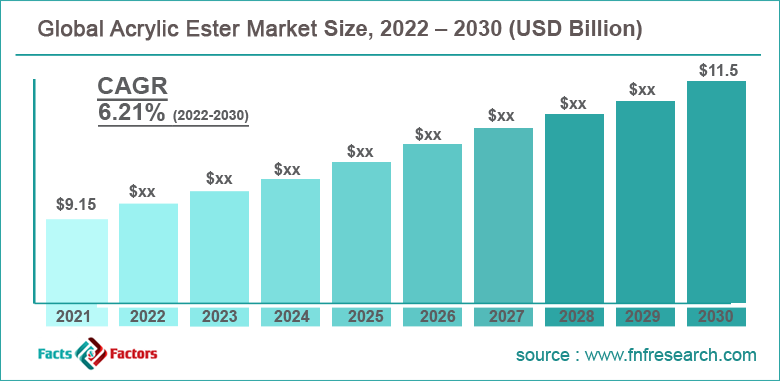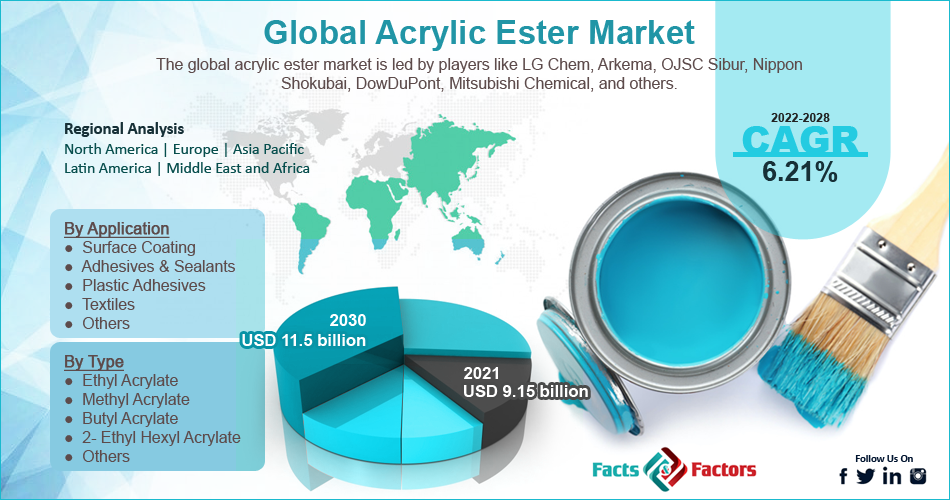Search Market Research Report
Acrylic Ester Market Size, Share Global Analysis Report, 2022 – 2030

Acrylic Ester Market Size, Share, Growth Analysis Report By Application (Surface Coating, Adhesives & Sealants, Plastic Adhesives, Textiles, and Others), By Type (Ethyl Acrylate, Methyl Acrylate, Butyl Acrylate, 2- Ethyl Hexyl Acrylate, and Others), and By Region - Global and Regional Industry Insights, Overview, Comprehensive Analysis, Trends, Statistical Research, Market Intelligence, Historical Data and Forecast 2022 – 2030
Industry Insights
[204+ Pages Report] According to the report published by Facts Factors, the global acrylic ester market size was worth around USD 9.15 billion in 2021 and is predicted to grow to around USD 11.5 billion by 2030 with a compound annual growth rate (CAGR) of roughly 6.21 % between 2022 and 2030. The report analyzes the global acrylic ester market drivers, restraints/challenges, and the effect they have on the demands during the projection period. In addition, the report explores emerging opportunities in the acrylic ester market.

 Market Overview
Market Overview
Acrylic esters are building blocks or essential components of various formulations used for the formulation of polymers. They are exceptionally versatile monomers. The component values of beta & alpha unsaturated carboxyl structure determine the traits of acrylic esters like their reactivity, flammability, and volatility. To create polymers, varying quantities of acrylic esters are used that help in the production of copolymer plastics, copolymers, and different types of cross-linking polymer systems. There has been tremendous growth in the end-user applications due to various advantages offered by acrylic esters like durability, different degrees of tackiness, glass transition temperature, and hardness.
The use of acrylic ester has allowed businesses making use of the chemical to constantly bring new innovations to their product lines. It allows the end products to showcase color stability along with resistance to heat and aging, high weather durability, and flexibility at low temperatures. One of the crucial factors that highly influence the demand for the monomer is its glass transition temperature which determines the temperature at which the final polymer will undergo a physical change from a brittle substance to a more flexible and softer solution.
 Key Insights
Key Insights
- As per the analysis shared by our research analyst, the global acrylic ester market is estimated to grow annually at a CAGR of around 6.21% over the forecast period (2022-2030)
- In terms of revenue, the global acrylic ester market size was valued at around USD 9.15 billion in 2021 and is projected to reach USD 11.5 billion, by 2030.
- The market is projected to grow at a significant rate due to the growing applications in the consumer goods segment
- Based on type segmentation, methyl acrylate was predicted to show maximum market share in the year 2021
- Based on application segmentation, adhesives & sealant coatings were the leading application in 2021
- On the basis of region, Asia-Pacific was the leading revenue generator in 2021

 Growth Drivers
Growth Drivers
- Growing applications in the consumer goods segment to propel market demand
The global acrylic ester market is projected to grow due to the increasing demand for acrylic ester monomers in the production of different types of every-day use consumer goods like diapers, detergents, and cosmetics. The chemical provides is one of the most used monomers in the end-application industries due to its properties like transparency, super-absorbency, toughness, and flexibility to name a few. This makes it highly valuable in the consumer goods segment. With research studies, it has been concluded that acrylic esters are superabsorbents of water. They can absorb it very freely and multiple times their own weight.
Some grams of the monomer can effectively absorb a high quantity of the liquid, lock it and hold it up tightly without leakage. They are also known as super-absorbers and hence, have found applications in the production of baby diapers. The other advantages like being effectively hygienic and hassle-free have helped in increasing their demand. Babies that use diapers made of acrylic esters do not register any condition related to harsh skin diseases.
 Restraints
Restraints
- Cytotoxicity of methyl acrylate to restrict market expansion
Methyl acrylates are state-of-the-art monomers and are hence widely used in the polymerization industry. Their applications in tissue engineering have increased in the last few years. However, there are several disadvantages associated with the use of methyl acrylates in the case of bone cement and dental fillings. They are known to cause irritability due to high cytotoxicity. This is because the biomolecules in the body create a double bond with methyl acrylates due to the Michael addition of thiol or amino groups. The main concern is owing to the fact that polymerization hardly reaches a 100% conversion of the double bond, due to the limited mobility of the monomer.
 Opportunities
Opportunities
- Increasing application as an oil additive to provide growth opportunities
n-Butyl methacrylate is used as an additive in the oil industry. It acts as a lubricant compound which helps to increase the quality and performance of the base oil. Oil companies are known to use either the same base stock or different additives for specific applications. Additives in the oil industry comprise around 5% of the oil weight. Nearly all motor oil, including petroleum-based or synthetic, is known to contain additives. Motor oil that lacks additives is known to be ineffective in protecting modern-age engines.
 Challenges
Challenges
- Limited information on the health impact of acrylic ester to pose as a major challenge
Currently, even with extensive research and studies, the exact impact of the use of acrylic ester on the health of living organisms and the environment is unknown which means that more research is needed for a final conclusion. However, the known fact is that after the lifecycle completion of such compounds, they mostly end up in landfills as only a handful of plastics or chemicals can be recycled.
 Segmentation Analysis
Segmentation Analysis
The global acrylic ester market is segmented based on application, type, and region
Based on application, the global market divisions are surface coating, adhesives & sealants, plastic adhesives, textiles, and others. In 2021. The global market registered the highest growth in the adhesives & sealants segment. The increase in restoration activities as well as the building of new residential and commercial buildings propelled the demand for sealants and are projected to continue the same trend during the forecast period. To get the Eiffel tower ready for the 2024 Paris Olympic Games, France launched a restoration project of USD 60 million, as quoted by France 24.
Based on type, the global market divisions are ethyl acrylate, methyl acrylate, butyl acrylate, 2-ethyl hexyl acrylate, and others. The growth is projected to be driven by methyl acrylate due to the high-end-user applications of the monomer, especially in the biomedicine segment. As per official data, around 200,000 tons of methyl acrylate is produced every year. The demand is high because it is used as a precursor to manufacture carpets.
 Recent Developments:
Recent Developments:
- In May 2022, the joint venture between SINOPEC and BASF broke ground by announcing the expansion of their tert-butyl acrylate production site in China. The plan will help the country meet the growing demand for chemicals in the country
- In April 2021, Tancheng County signed 21 projects across 6 groups with a total investment of 20.4 billion yuan. 4 projects from the second group focus on the production of acrylic acid, refined acrylic acid, and acrylic esters
 Report Scope
Report Scope
Report Attribute |
Details |
Market Size in 2021 |
USD 9.15 Billion |
Projected Market Size in 2030 |
USD 11.5 Billion |
CAGR Growth Rate |
6.21% CAGR |
Base Year |
2021 |
Forecast Years |
2022-2030 |
Key Market Players |
LG Chem, Arkema, OJSC Sibur, Nippon Shokubai, DowDuPont, Mitsubishi Chemical, and others. |
Key Segment |
By Application, Type, and Region |
Major Regions Covered |
North America, Europe, Asia Pacific, Latin America, and the Middle East &, Africa |
Purchase Options |
Request customized purchase options to meet your research needs. Explore purchase options |
 Regional Analysis
Regional Analysis
- Asia-Pacific to lead with a highest growth rate
The global acrylic ester market is projected to register the highest growth in Asia-Pacific with China leading with the highest regional CAGR. The growth can be attributed to the growing investments by the Chinese government in the chemical industry. As of 2022, China is the leading economy in terms of the chemical industry. It is the largest producer and supplier of some of the most crucial chemicals across the globe.
In recent time, the production of acrylic ester-related projects have grown in China either due to the domestic players taking up new opportunities or due to the entry of foreign business. Recently, Satellite Chemical, one of the major giants in the production of acrylic acid, announced the expansion of the scale of the ester industry in the country. Wanhua Chemical is also recorded to have accelerated the production processes. In 2021, Bohai Dongfang Chemical Co., Ltd. announced that it will put almost 80,000 tons of acrylic ester and acid into production in the same year.
 Competitive Analysis
Competitive Analysis
- LG Chem
- Arkema
- OJSC Sibur
- Nippon Shokubai
- DowDuPont
- Mitsubishi Chemical
The global acrylic ester market is segmented as follows:
 By Application Segment Analysis
By Application Segment Analysis
- Surface Coating
- Adhesives & Sealants
- Plastic Adhesives
- Textiles
- Others
 By Type Segment Analysis
By Type Segment Analysis
- Ethyl Acrylate
- Methyl Acrylate
- Butyl Acrylate
- 2- Ethyl Hexyl Acrylate
- Others
 By Regional Segment Analysis
By Regional Segment Analysis
- North America
- The U.S.
- Canada
- Mexico
- Europe
- France
- The UK
- Spain
- Germany
- Italy
- Nordic Countries
- Denmark
- Sweden
- Norway
- Benelux Union
- Belgium
- The Netherlands
- Luxembourg
- Rest of Europe
- Asia Pacific
- China
- Japan
- India
- Australia
- South Korea
- Southeast Asia
- Indonesia
- Thailand
- Malaysia
- Singapore
- Rest of Southeast Asia
- Rest of Asia Pacific
- The Middle East & Africa
- Saudi Arabia
- UAE
- Egypt
- South Africa
- Rest of the Middle East & Africa
- Latin America
- Brazil
- Argentina
- Rest of Latin America
Industry Major Market Players
- LG Chem
- Arkema
- OJSC Sibur
- Nippon Shokubai
- DowDuPont
- Mitsubishi Chemical
Frequently Asked Questions

Copyright © 2025 - 2026, All Rights Reserved, Facts and Factors


